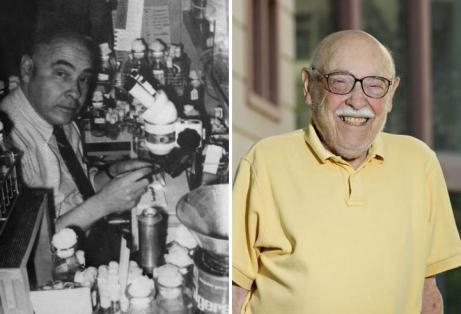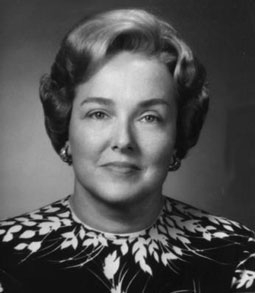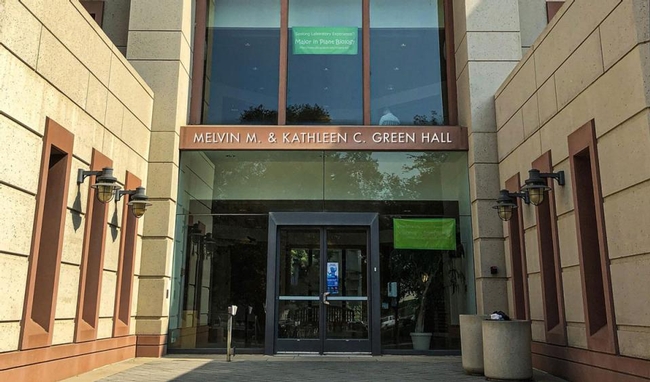
Green Hall memorializes two outstanding scientists--Mel, a geneticist, and wife Kathleen, a biologist.
Melvin Green, who died Oct. 24, 2017 at age 101, was a UC Davis distinguished professor emeritus of molecular and cellular biology who co-founded the UC Davis Genetics Department (now part of the Department of Molecular and Cellular Biology). Kathleen, who died in 2002, was a UC Davis biologist and a longtime Davis City Council member--she was the first woman elected to serve on the council. A scholarship in her name honors women in science.
Selected the 1971 Davis Citizen of the Year, Kathleen served the community in a number of capacities, including charter member and president of the League of Women Voters in Davis, and a member of the the Sutter Davis Hospital Board of Directors.
Brilliant Scientist
During Mel Green's 60-year career, he was inducted into the National Academy of Sciences and received two Guggenheim fellowships. He inspired generations of students, faculty and staff.
We never met Kathleen, but we knew Mel as a brilliant scientist and a wonderful conversationalist, with a finely honed sense of humor. He was a frequent visitor in the halls and offices of the Department of Entomology and Nematology.

Leal and dozens of colleagues spearheaded a movement among the faculty to rename the building. UC Davis Chancellor Gary May approved the name.
"Not many know that Mel, who grew up in the Depression in a Jewish ghetto, became not only a first-generation college graduate in his family but also the first Jewish person to receive a Ph.D. in zoology and biochemistry from the University of Minnesota (1942)," Leal related. "Mel served in the U. S. Army during World War II, and then joined the UC Davis faculty in 1950. He worked until his nineties. During his lengthy and productive career, he made seminal discoveries concerning the nature of mutations using the fruit fly, Drosophila melanogaster. In particular, Mel is known for his discovery of mobile DNA elements."
"Mel would stop by my office on a regular basis just to check on me, talk science, and sometimes to tell a nice joke. For example, in October 2004 he showed up early in the morning and told me: 'Walter, you are screwed!' I asked why and he told me 'Richard Axel and Linda Buck just got the Nobel Prize for their work on olfaction.' I had a good laugh.'"
Mel connected widely and often with UC Davis entomologists, including Bruce Hammock, Hugh Dingle, Lynn Kimsey and Robert Kimsey. Lynn, director of the Bohart Museum of Entomology and a professor of entomology, identified the insect taxonomy for Mel's article, "It Really Is Not a Fruit Fly," appearing in the Sept. 1, 2002 edition of the journal Genetics.

In the article, Green pointed out that the genus Drosophila includes more than 1000 species. He argued that all Drosophila species "should be referred to by their scientific, not their common name."
Mel wrote that "real fruit flies, e.g., the Mediterranean fruit fly, the Oriental fruit fly, and other members of the family Tephritidae, attack unblemished fruit and in heavy infestations cause serious economic damage. In contrast, even if present in enormous numbers, D. melanogaster is innocuous and of no economic importance."
But to a "layperson's unsophisticated eye," the insects hovering over a fruit bowl, evoke the term, evoke "fruit fly," not "vinegar fly," the geneticist wrote.
The UC Davis campus bursts with buildings named for outstanding faculty, including:
- Asmundson Hall, named for Professor Vigfus Asmundson
- Briggs Hall,named for Professor Fred N. Briggs
- Everson Hall: Professor Gladys Everson
- Hutchison Hall: Professor Claude B. Hutchison
- Kleiber Hall: Professor Max Kleiber
- Bainer Hall: Professor Roy Bainer
And now, the list includes Green Hall, a fitting tribute to the careers of Melvin and Kathleen Green. (See UC Davis news story)
Attached Images:
